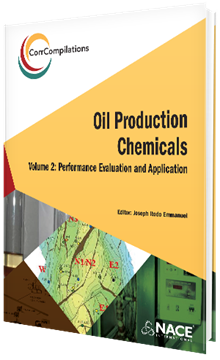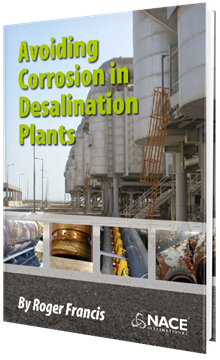The “CorrCompilation: Oilfield Production Chemicals” series covers production, selection, performance evaluation, application, monitoring, and optimization of oilfield chemicals. The oilfield chemicals presented are corrosion inhibitors, biocides, scale inhibitors, and drag reducers. The editor, Joseph Itodo Emmanuel, believes it is a “must-have reference book” for corrosion engineers in the field, technicians, and field operation supervisors due to its broad spectrum.
He suggests the compilation could be used for a university-level engineering or scientific course on oilfield chemicals or tailored training to enhance the technical knowledge of field personnel on oilfield chemical application and management.
Since this CorrCompilation consists of 90 NACE technical papers or articles, it is published in three volumes.
Volume 1: Development and Selection
Volume 2: Performance Evaluation and Application
Volume 3: Monitoring and Optimization
Each volume contains current research findings, field treatment practices, best practices, and scientific and engineering concepts.
2019 NACE e-book
Product Number:
37632-e
ISBN:
978-1-57590-376-7
Author:
Edited by Joseph Itodo Emmanuel
Publication Date:
2019
$97.50
$130.00
$130.00
The “CorrCompilation: Oilfield Production Chemicals” series consists of three volumes and presents oilfield chemicals used for flow assurance and corrosion-control purposes in the oil and gas industry.
The papers presented provide comprehensive and up-to-date information on the development, selection, performance evaluation, application, monitoring, and optimization of four oilfield chemicals: corrosion inhibitors; biocides; scale inhibitors; H2S scavengers, dispersants, and drag reducers. Oilfield chemicals are applied to oil and gas wells, production equipment, transmissions, and gathering pipelines and utilities.
Corrosion inhibitors are applied in batches or on a continuous basis in minimum concentrations to control and lower the corrosion rate to an acceptable level. The goal is to achieve and possibly exceed the design life of the asset while maintaining asset integrity.
Biocides are applied by batch or slug treatments in the dose recommended by the manufacturer or determined to achieve maximum effectiveness during the field trial.
Scale inhibitors are used in the field if there is a known risk of asset damage due to scale—either from existing or previous field operations, experiences, or model predictions.
Drag reducers are used in oil and gas pipelines to reduce frictional losses and turbulence and improve flow efficiency and capacity for production.
This first volume, "Development and Selection," is arranged in two sections:
• Development of Oilfield Chemicals, which focuses on test methods, procedures, techniques, and parameters of interest evaluated or considered in the development of oilfield chemicals to increase the chemical effectiveness and lower the cost of treatment per dosage applied.
• Selection of Oilfield Chemicals, which focuses on operating conditions, water chemistry, compatibility with injection and production systems, compatibility with other chemicals, performance against corrosion at simulated field conditions and expected conditions, process parameters (temperature, flow velocities), tests to be conducted, and factors and field trial requirements to be considered during oilfield chemical testing and selection.
2019 NACE e-book



